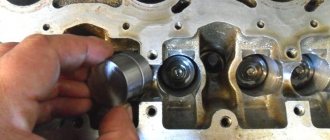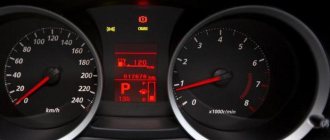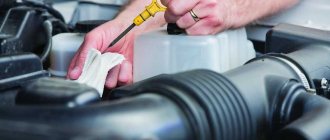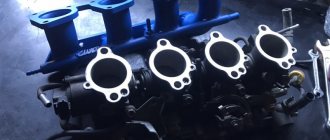Any experienced car enthusiast knows how important the gas distribution system, abbreviated as timing, is in a car. Its task is to supply air to the cylinders, where a working mixture is created to start and operate the engine. After the mixture burns out, exhaust gases are formed, which must be removed from the system, and here the timing belt also plays a decisive role.
For the correct operation of the timing belt, reliable operation of the hydraulic compensators is important. These devices are responsible for opening and closing the air intake valves. Moreover, they are responsible for opening the valves to a strictly defined amount, no more and no less.
If the hydraulic compensators break down, the gap size will be disrupted, which will lead to a phase failure of the gas distribution system. A car enthusiast can detect a problem by a characteristic knocking sound, which often causes panic even for experienced drivers. Today we’ll talk about how hydraulic compensators are replaced on a Priora with a 1.6 engine with 16 valves with or without air conditioning.
What it is?
The part is a small hydraulic device. It automatically eliminates the effects of linear expansion in the valve train mechanism during engine operation as parts expand.
The gaps are adjusted using the oil pressure in the engine. The gap is adjusted between the valve and the camshaft. With the help of such compensation of thermal gaps, the engine does not lose dynamic characteristics, fuel consumption is optimal after warming up. Also, due to the presence of hydraulic compensators in the VAZ-2112, the engine is quieter than similar engines with a mechanical valve adjustment system.
Design of hydraulic compensators
Let's look at the design and principle of operation of a hydraulic pusher using the example of a hydraulic pusher installed in the cylinder head. The remaining types of hydraulic lifts, although different in design, work on the same principle. The hydraulic pusher is a housing with a pair of movable pistons with a ball valve installed inside. The housing is configured to move relative to the guide socket obtained in the head. If the main valve is installed in the valve actuation levers (rocker arms or rocker arms), then its only moving part is the plunger, the protruding part of which is made in the form of a ball joint or support pad.
The main part of the main engine is a pair of pistons. The gap between the sleeve and the plunger is only 5-8 microns, which ensures high tightness of the connection while maintaining the mobility of the parts. At the bottom of the plunger there is an opening for oil flow, which is closed by a spring-loaded check ball valve. A fairly stiff return spring is installed between the sleeve and the plunger.
How did they appear?
The hydraulic compensator on VAZ cars has replaced ineffective mechanical adjustments of the timing mechanism. Often a regular valve on classic VAZ engines is not equipped with a compensator. Therefore, drivers adjusted valve clearances every 10 thousand kilometers. The work had to be done manually. The valve cover was removed, measurements were taken with a feeler gauge and the required gap was set.
If the driver did not adjust the valves, the engine operation was accompanied by loud noise, dynamics were lost, and fuel consumption increased. After about 50 thousand kilometers, the valves required replacement, as they were severely worn. As an alternative to mechanical adjustment, AvtoVAZ decided to offer a more modernized design.
On engines for front-wheel drive cars, special pushers were installed in front of the valve. A “hat” was put on the valve. The diameter of the pusher is large enough, and due to this, wear has been reduced. It takes longer for a larger diameter to wear out. Yes, the wear rate has decreased, but the need to adjust the valves remains, although now it has to be done less often.
Typically, tuning consisted of adding tuning washers, which decreased or increased the height of the pusher. This adjustment, despite its archaic nature, is quite effective, and some automakers use this method to this day. Valve clearances in such a mechanism need to be adjusted once every 50 thousand kilometers. On some foreign cars, pushers can live even longer.
Among the advantages of this solution are the simplicity of the design, the absence of oil requirements - even mineral oil will do. In addition, the design turned out to be very cheap. Among the disadvantages, reviews note that if the washer has worked, then the engine becomes noisy, fuel consumption increases, and dynamics decrease. AvtoVAZ thought about a design that would automatically regulate thermal clearances in the valve mechanism.
And so, instead of mechanical adjustments, VAZ-2112 hydraulic compensators appeared. At that time it was a completely new technology. In fact, everything is very simple - the driver no longer needs to manually adjust the gaps. The hydraulic compensators themselves will automatically select the desired parameter for each valve.
Which hydraulic compensator is making the knocking noise?
To determine which hydraulic compensator is making a knock (usually their number is equal to the number of valves in your engine), they use a diagnostic method “by ear”, using a technological version of such a medical device as a phonendoscope - you have almost certainly seen it on your therapist’s neck.
It is this device that allows the master to say exactly where the source of the knocking lies, although real professionals, of course, will determine this without any phonendoscope.
After diagnosing the knocking part, you need to remove the hydraulic compensator, thoroughly clean it, then install it in place and start the engine again.
If the knocking noise persists, the hydraulic compensator is considered to be out of order, and the service will replace it.
If the knocking continues after replacement, the reason most likely lies in the quality of the oil used, or in other engine components. The latter is unlikely, since diagnosing a sound source using a phonendoscope is an accurate procedure and, as a rule, does not cause failures.
Principle of operation
The hydraulic compensator is an intermediate part between the valve and the camshaft cam. When the cam does not exert pressure on the compensator, the valve is closed under the action of the cylinder head spring. Inside, a spring presses on the parts of the plunger pair. Due to this, the compensator body moves towards the camshaft cam until it completely rests against it. In this case, the gap will be minimal.
The required pressure inside the plunger pair is exerted due to oil pressure. It is fed through channels into the cylinder head and then passes through the holes in the compensator. Then inside it bends the valve and creates the necessary pressure.
Next, the cam goes down and presses on the compensator. The oil inside the plunger presses on the valve and closes it. The compensator turns into a rigid element, which, under the pressure of the cam, opens the valve of the timing mechanism.
It must be said that the hydraulic compensators on the VAZ-2112 (16 valves) are quite highly efficient devices. The oil is squeezed out of the plunger before the ball closes. So, a very slight gap may form, which will go away the next time the oil is supplied. The compensator will become rigid again.
It doesn’t matter to what temperature the engine is heated: the gap will always be the most optimal. The mechanism does not require adjustments during its entire service life. Even if there is wear, adjustment is not necessary. The compensator is always pressed against the camshaft.
The process of replacing hydraulic compensators on a 16-valve valve
Hydraulic compensators produced by AvtoVAZ
So, if the diagnostics showed that the hydraulic compensators are out of order, then we replace them. Of course, first of all, you need to buy new ones. Now, consider the sequential replacement process:
- We dismantle the upper protective cover.
Fastening bolts are marked with an arrow
- We remove the receiver.
Removing the receiver from the car
- Now, it is necessary to dismantle the ignition module.
We unscrew the fastenings and dismantle the ignition model
- Disconnect the crankcase ventilation hose.
Unscrew the clamp and remove the crankcase ventilation hose
- Using a 10mm wrench, we dismantle the injector wiring harness bracket.
Using a wrench, unscrew the fastenings of the wiring harness.
- We dismantle the valve cover.
Removing the valve cover
- Now, you need to carry out diagnostics and press on the drifts.
The principle of operation and diagnostics of hydraulic compensators
- Next, we dismantle the camshaft pulleys.
We jam the camshafts and remove them
- Disconnect the oil pressure sensor wires.
Removing the oil pressure sensor
- Remove the bolts that secure the camshaft bearing housing.
Unscrew the camshaft mounting bolts
- We dismantle the rear support of the power unit.
Unscrew the rear engine mount
- Now, you need to remove the camshaft bearing housing.
We take out the bearing housing
- The spark plug wells need to be removed from the housing. Inspect them for the presence of oil.
- We dismantle the camshafts assembled with oil seals.
Removing the camshafts
- Remove the plugs that are located on the head and camshaft housing.
We take out the block head plugs
- We remove the hydraulic compensator from the cylinder head.
We take out the hydraulic compensators
- Lubricate the bearing journals and cams.
- We install new hydraulic compensators.
- We carry out the assembly in the reverse order, observing the order and tightening torque of the cylinder head.
If the replacement is correct, then after assembly and the first start of the engine, nothing should knock. If the knock remains, you need to disassemble everything again and carry out diagnostics, and then fix the problem.
Selection of hydraulic compensators
The choice of any spare part must be taken quite seriously. Hydraulic compensators are no exception. Let's consider possible options for installing them on the VAZ-2112 series:
- 2112-1007300 is the original catalog number of hydraulic compensators for the VAZ-2112. The cost is 3300 rubles . Manufactured by AvtoVAZ.
- Herzog HL0 7300 – an analogue substitute for the original part, which can be used for installation on a car. The price is 2700 rubles.
Hydraulic compensators manufactured by Herzog
- Master-sport 2112-1007300-SET/16/-MS is one of the options for replacing the original hydraulic compensator made in the Russian Federation. Certified and recommended for installation.
Causes of sound
One of the most basic reasons is related to the quality and level of engine oil. So, most often a knock is heard due to insufficient level. Oil flows ineffectively into the oil channels and does not enter the plunger pair. As a result, there is no necessary pressure in the hydraulic compensator for its full operation.
The oil channels in the cylinder head or in the compensator itself may also be clogged. This happens due to untimely oil changes. It burns, and carbon deposits form on the walls of the mechanism. The latter can clog the channels of the lubrication system. Oil is not able to effectively flow inside the hydraulic compensator.
Mechanical problems can also be identified. Most often, the hydraulic compensator on the VAZ-2112 (16 valves) knocks due to the failure of the plunger pair - these elements are jammed. There will be a knock if the ball valve in the plunger has failed. The sound may also indicate carbon deposits on the outer part of the plunger body. It does not allow the mechanism to move and automatically adjust the gap.
Hydraulic compensators and malfunctions in them
Let's immediately determine that the knocking of the hydraulic compensator is a problem that occurs in 90% of cases not on new cars, although exceptions are possible if a low-quality part was installed at the factory. But this is also unlikely, since the hydraulic compensator belongs to the power unit, and factories producing engines have much more stringent requirements regarding the quality of components supplied by suppliers.
Problems with knocking hydraulic compensators can arise over time on a car of any make, year and country of manufacture.
There are a number of ways to eliminate annoying sound, each of which should be used in a specific situation.
But in order to understand why the hydraulic compensator is knocking and the reason for its failure, you first need to understand what kind of mechanism it is, what it consists of, and how it functions. And in general, what can such a knock lead to, and what will happen if it is not eliminated in a timely manner.
How to solve the problem?
The most effective solution is to replace the hydraulic compensators on the VAZ-2112. But if carbon deposits have formed in the system, then these mechanisms are removed and washed. After washing, it is sometimes possible to restore their functionality. However, if the car has high mileage, then the compensator breaks and then only needs to be replaced.
The quality of the mechanism largely depends on what kind of oil is poured into the engine and how often it is changed. For quiet and reliable operation of the automatic thermal gap compensation mechanism, it is necessary to fill in high-quality synthetic oil and change it regularly. Then the elements will last longer. Sometimes a less viscous oil may be required to increase the pressure in the system.
conclusions
The reasons for the knocking of hydraulic compensators are quite simple, and their classification immediately indicates the reasons for the occurrence of this effect. The main method of troubleshooting remains a comprehensive replacement of all products.
I remember trying to install hydraulic compensators on the “six” so as not to set the valve clearances. The car immediately became dumber. A year later, during the next renovation, I removed them. And on the “twelfth” they are still working well. To avoid foam, you need to fill in high-quality oil.
I noticed that my hydraulic compensator was starting to tap, so I went to take a look. It turned out to be worn out and had to be replaced with a new one.
Sometimes you just need to change the engine oil and the knocking goes away. That is, if you change the oil at the wrong time (more than 10,000) due to dirt, let’s say they get stuck.
On a 2110 16 valve, after the engine warms up to 70′, a metallic knock or a clatter appears, and so on constantly while the engine is hot, when cold it works normally, without this clatter, what is the reason?
Yes, I'm sorry, the clatter appears in the cylinder head area where the camshafts are.
I changed the oil and the knocking does not go through the compensators
So I was hooked on this problem, the knocking of the hydraulics, whether it’s cold or hot, Lukoil Armotek 5-40 synthetic oil drove three thousand on it and one morning when they started bubbling it became scary, before that they knocked, but when the engine warmed up they stopped using the same oil. I consulted with familiar service technicians, like pour 500 ml of salya into the oil and let the engine run for 3-5 minutes on this mixture and drain it, then pour in the flushing oil and rinse. I thought that I should try just changing the oil and filter, like pour in cheap oil, run it, warm it up, and then fill it with a better one. I bought a Gasprom 10-40 and replaced the filter and oops there was a tapping sound like one gidriu and not loudly, I gave it 4000 rpm, it pumped everything up, everything became quiet, in the morning when it was cold there was no break at all and the rpm calmly began to luxuriate. Before changing the oil, while I was going to Mogaz, I turned the engine to 4500 the knocking seemed to subside and then appeared again at XX. I arrived at the garage at idle and it rattles, then it seems to disappear and the noise goes away again. I changed the oil and the rattling went away. While I'm driving around on 10-40 gas with a synthetic floor and a new Linux filter. Tolley oil... but only the filter I don’t know. But due to the increase in prices because of this virus, hydraulics cost 5400. It’s kind of expensive. Engine 21124 with mileage 273000 without capital. Oil pressure at XX 1.5-2.0 kg with increasing speed increases. So well, this engine works and let It’s working. I’ll try to measure the oil pressure on the new oil. If anything, I’ll let you know.
Source
Diagnosis of GCC
Listening to knocks and monitoring the dynamics of the VAZ 2107 engine is, of course, a useful habit. But you still have to roll up your sleeves and drive the car into the garage. After all, for an accurate diagnosis, you need to get the device and inspect it personally.
- Remove the valve cover.
- Using a special wrench, rotate the crankshaft so that the cylinder piston is in the compression stroke.
- Try pressing the rocker arm on the intake valve.
If the rocker arm easily gives in to your efforts, the hydraulic compensator requires replacement.
You can also check the functionality of the hydraulic supports using a screwdriver. If you press on a faulty mechanism, it will give play.
Replacing rocker arms on a VAZ 2107
Rockers (rocker arms) are one of the elements of the valve timing mechanism of the VAZ 2107 engine. The purpose of the part is to transmit energy from the camshaft cam to the valve stem. Since the rocker is constantly exposed to mechanical and thermal stress, it wears out over time.
Rocker arms are designed to transfer energy from the camshaft lobe to the valve stem
Determining the suitability of rocker arms
If during operation of the “Seven” there is a decrease in engine power or a characteristic knocking sound is heard in the cylinder head, then the likely cause is a broken rocker arm. During repair work, it is necessary to clean the rockers from dirt and carbon deposits and check them for wear and damage. If any defects in parts are found, they are replaced with new ones. If the rocker arms are in normal condition, install the products on the cylinder head.
If the rocker arm is heavily worn or there is visible damage, the part needs to be replaced
Is it possible to level the rocker arm?
When adjusting valves or repairing the cylinder head, you may notice that the rocker arms are slightly at odds with respect to the camshaft, i.e., the distance between the rocker plane and the camshaft journal is not the same. To eliminate this nuance, some owners of “classics” align or change the springs that press the rocker arms, or replace the rocker itself, but the problem may still remain. In fact, on all classic Zhiguli models, including the VAZ 2107, misalignment is not as bad as incorrect valve clearance. Therefore, it is the gap that deserves attention. The main thing is that the parameter is adjusted properly and is 0.15 mm when cold.
When the rocker arm is skewed, some motorists change the part itself, the springs, and sometimes the camshaft, but they do not achieve the desired effect
How to replace a rocker arm
If there is a need to replace the rocker arms on the “seven”, for example, 1 part in case of its breakdown, then it is not necessary to dismantle the camshaft. To do this, it will be enough to pry the spring with a screwdriver, remove it, and then remove the rocker itself. The new part is installed in the reverse order. If all the rocker arms are being replaced, then it is wiser to dismantle the camshaft.
Basic faults
Hydraulic compensators, like any car part, tend to wear out and break. They are constantly under load. But they work for a long time: from 120 to 150 thousand mileage. Sometimes they fail ahead of time.
Two circumstances indicate a malfunction:
- a characteristic knocking sound appears, reminiscent of a clattering sound;
- motor power decreases.
Engine knock
The main sign of wear of a spare part is the appearance of a clattering sound. Since extraneous knocking noises can occur on the VAZ 2107 for various reasons, you need to check what is its source. To do this, you will have to open the hood and start the engine.
A characteristic clattering sound comes from under the valve covers and does not disappear while the engine is running. At the same time, the sound may have interesting features.
- The knocking noise appears on both a warm and cold engine. If you increase the speed, it may stop. This indicates possible valve ball wear. The hydraulic compensator will have to be completely replaced. But before doing this, make sure that the device is not dirty. A good cleaning may easily fix the problem.
- The engine starts knocking only after warming up. This indicates that the elements of the part have worn out. It's time to buy a new one.
- The characteristic clattering sound appears only at elevated speeds. Most likely there is too much or too little oil coming in. You need to check its level. And if necessary, repair the oil receiver.
- The knocking is constantly present and does not subside under any conditions. This usually occurs when there is a gap between the rocker and the camshaft lobe. Try cleaning the hydraulic compensator or replacing it with a new one.
Reduced power of the power unit
If the hydraulic compensator malfunctions, this inevitably leads to a decrease in engine power. You will feel that the dynamic characteristics of the VAZ 2107 have decreased. And this is not surprising!
Indeed, as a result of an incorrectly set valve clearance, the wrong amount of fuel enters the engine. As a result, the fuel mixture is formed in incorrect proportions, which reduces the power of the power unit.











